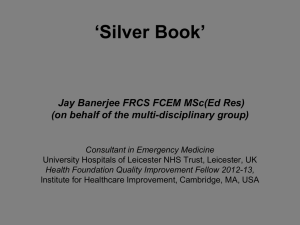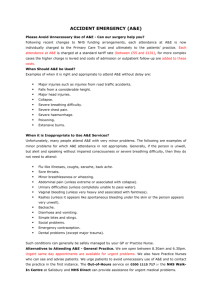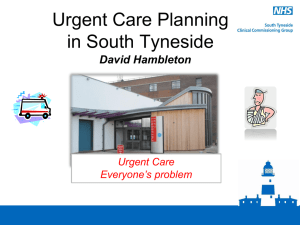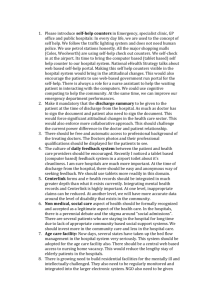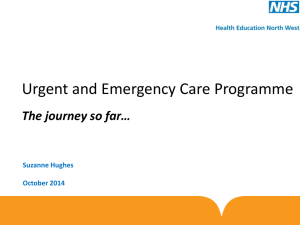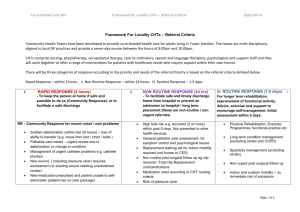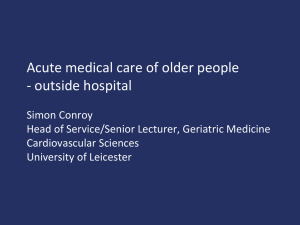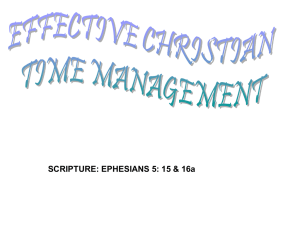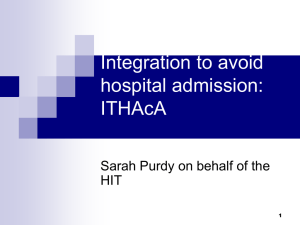Dr Jay Banerjee Consultant in Emergency
advertisement
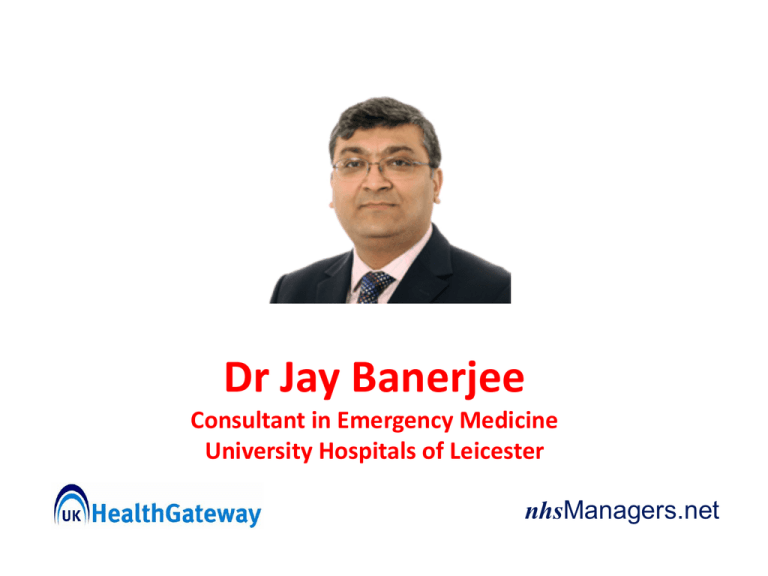
Dr Jay Banerjee Consultant in Emergency Medicine University Hospitals of Leicester nhsManagers.net Older people: urgent/emergency care • • • Over the next 20 years, the number of people aged 85 and over in the UK is set to increase by two-thirds, compared with a 10 per cent growth in the overall population. ≥60 years account for 23% of attendances to the EDs and compared to the 21-59 age group, are more likely to arrive by ambulance, have more investigations done and despite similar booking in and assessment times, spend a longer time in the ED. The admission rates for the over 60s is also higher compared to the 2159 years age group and they account for 43% of all admissions to hospitals in England and Wales. Hospital bed use Annual costs: in £000’s/person with disease (UK, 2010) – burden of disease National reports NHS NHS must close the gap between the promise of care and compassion outlined in its Constitution and the injustice that many older people experience (Health Service Ombudsman, 2011) 35% of inspected hospitals needed to improve, 25% did not meet 1 or 2 standards (Care Quality Commission, 2011) patients’ privacy not being respected – for example, curtains and screens not being closed properly (CQC) staff speaking to patients in a dismissive or disrespectful way (CQC) how often should a patient be told that “because of being unable to use the toilet… she should wet the bed”? Is that OK as long as it is only 10 times a month or 20? (Patient Association, UK, 2011) Francis report (February 2013) Berwick report (August 2013) Hospital outcomes Negative outcomes in hospital including HAI, falls, delirium, pressure ulcers, diagnostic errors, missed diagnosis, adverse drug reactions, death Negative outcomes post discharge including high readmission rates, functional decline, death, institutionalisation Reports of poor care, invasion of privacy and dignity, lack of compassionate care Increasing attendance to ED? While a substantial research literature describes general patterns of ED use, there is much less research on ED use as a function of other health service use. Gaps in the research literature result in a limited understanding of the full scope of the issue and opportunities for practice and policy intervention (Gruneir et al. Emergency Department Use by Older Adults: A Literature Review on Trends, Appropriateness, and Consequences of Unmet Health Care Needs . Med Care Res Rev April 2011 68: 131155, first published on September 9, 2010) Purpose of Silver Book Describes the issues relating to older people accessing urgent care in the first 24 hours irrespective of provider Describes the competencies required to respond Recommends urgent care standards for older people - first 24 hrs of an acute care episode Membership Age UK Assoc. of Directors of Adult SS British Geriatrics Society Chartered Society of Physiotherapy College of Emergency Medicine College of Occupational Therapists Community Hospitals Association Emergency Nurse Consultants Assoc. National Ambulance Service Med. Dir. Society for Acute Medicine Royal College of General Practitioners Royal College of Nursing Royal College of Physicians Royal College of Psychiatrists Silver Book: “Is” and “Isn’t” This document is a best practice guideline, comprising recommendations based on a review of the literature and refers to evidence where available It does not describe the commissioning and mode of delivery of the competencies, as these will vary according to local needs, resources and policies The older person’s care needs may be delivered in the emergency room, the acute medical unit or a community setting depending on local service configuration. Underpinning principles Respect for the autonomy and dignity of the older person must underpin our approach and practice at all times. A whole systems approach with integrated health and social care services strategically aligned within a joint regulatory and governance framework, delivered by interdisciplinary working with a patient centred approach provides the only means to achieve the best outcomes for frail older people with medical crises - Focus on Long Term Conditions (heart failure/frailty/dementia/ COPD) - More effective responses to urgent care needs - Advance care planning/end of Life care plans - Targeted input into Care Homes -Access to integrated services through NHS Pathways (3DN) including health & social care Clear operational performance framework integrated with GP processes Ready access to specialist advice when needed Improved integration with 1° & 2° responders via NHS Pathways Front load senior decision process including primary care, ED Consultants& Geriatricians General Practice & GP OOH Community Support Objective: A left shift of activity across the system as a function of time; yesterday’s urgent cases are today’s acute cases and tomorrow’s chronic cases. 999 ED Optimise emergency care: - Evidence based management - Multidisciplinary input from PT / OT & community matrons - Access to intermediate and social care - Front line geriatrician input - Effective information sharing with primary care/ secondary care/ community - Develop minimum data set AMU Inpatient wards - Redesign to decrease LOS with social & multidisciplinary input using a “pull” system - Effective Date of Discharge - Ambulatory care (macro level) for falls/LTC Whole system metrics Proportion of urgent care encounters in primary care leading to a hospital attendance and separately hospital admission in people aged 65+/75+/85+ ED attendance and re-attendance rate per 1000 population of 65+/75+/85+ Emergency department conversion rate for people aged 65+/75+/85+ per 1000 population Hospital readmission rates for people aged 65+/75+/85+ and ED re-attendance rate for same group Rates of long term care use at 90 days post-discharge following ED attendance and discharge from hospital for people aged 65+/75+/85+ Mortality rate per 1000 in the 65+/75+ and 85+ Patient and carer satisfaction survey Staff satisfaction survey Comprehensive assessment Standards – eg. There must be an initial primary care response to an urgent request for help from an older person within 30 minutes The presence of one or more frailty syndrome should trigger a more detailed comprehensive geriatric assessment, to start within 2 hours (14 hours overnight) either in the community, patient’s own home or as an in-patient, according to the patient’s needs Recommendations Generic – across all settings in first 24 hrs; including discharge - - planning Specific – include Primary care Community hospitals ED/UC/AMU Mental health Safeguarding Major incident planning Commissioning Training and development for all staff groups Staff competencies - generic Communication including listening skills Compassion, empathy and respect Clinical reasoning and assessment skills Time/patience and the ability to build a rapport Awareness of community services Risk assessment surrounding discharge planning Multidisciplinary team working skills Personal care training skills Moving and handling skills Basic life support skills Ability to balance contrasting needs of a complex person Delivery Some practice points Assessment of needs - individual/population Develop system-wide competencies - to deliver CGA Tailor services locally - resources, cost, availability Consider workforce implications Foster multi-disciplinary collaborative at micro, meso- and macro- level Moving on…. • “Acting our way into a different way of thinking”……the Silver Book can serve as a useful guide
